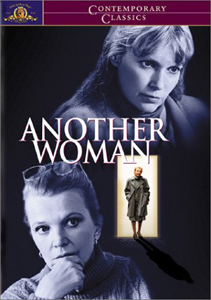It’s been said the biggest sin in an actress’ career is turning 40. But there are exceptions where a 40-plus actress gets an amazing role. One example is Woody Allen’s “Another Woman” (1988), which centers on a reserved yet magnetic Gena Rowlands as Marion.
Getting to know Marion
It’s also a rare film enhanced by the lead’s regular voiceover narration. Off the bat, Marion tells us her life has been satisfying so far, and we have no reason to doubt her. But “Another Woman” gradually peppers in equally cerebral husband Ian Holm and a dashing alternative in Gene Hackman.
If it were merely a love triangle, “Another Woman” would be good, but it reaches masterpiece status by giving us a thorough accounting of Marion’s first 50 years. We get this info simultaneous with Marion thinking about her past.

“Another Woman” (1988)
Director: Woody Allen
Writer: Woody Allen
Stars: Gena Rowlands, Ian Holm, Mia Farrow
Among the specifics: She had a rocky first marriage, and her relationship with her brother has soured. Allen had recently turned 50, and there are some broad observations about the milestone, like in this exchange:
Hope: “Oh, gee, 50’s not so old.”
Marion: “No, I know it isn’t, but … you just suddenly look up and see where you are.”
Hope: “You’re in a good spot, aren’t you?”
Marion: “Well, I thought I was. But then there’s chances gone by you can’t have back again.”
While there have been cases of writers gender-swapping themselves to tell a personal story (such as Bo Burnham in “Eighth Grade”), I don’t get any sense of Allen in Marion. She has none of the open neuroses and self-deprecating one-liners of an Allen Character.
This plays like a woman’s story specifically because of Marion’s regret about not having a child.
And because actresses get fewer roles after 40, “Another Woman” is refreshing in its rarity. The voiceovers and other stylized elements make me think of TV’s “Once and Again,” where Sela Ward landed a gem of a middle-aged role.
Accidental psychiatric session
While Marion is her own person, the nature of self-reflection is staged in an intriguing, universal way via a unique setting. Marion, a philosophy professor on sabbatical to write a book, rents an empty apartment to use as office space. Next door is a psychiatry office where we hear a troubled Mia Farrow as Hope, through the air vent.
The sublet apartment features only furniture and a smattering of what the renter left behind. With its incomplete rows of books, along with Hope’s voice coming through the vent, it’s a metaphor for Marion’s mind.
While Farrow has been in many great Allen pictures, I think she’s at her best in small doses. In “Another Woman,” Rowlands is the main dish and Farrow – despite claiming the main spot on the DVD cover — is the spice. Hope allows Marion to recognize the same problems in herself. And she later learns Hope has seen her, Marion, as a cautionary tale.

Great supporting cast
The film is impeccably cast. Holm plays cold fish Ken in a way we recognize from “Alien” and “Garden State.” Sandy Dennis is childhood friend Claire, who reveals that Marion stole a boyfriend from her without realizing it. Martha Plimpton adds a youthful touch as a stepdaughter who looks up to Marion.
When Hackman’s naturally appealing Larry (especially against the stiff Ken) comes on screen, we immediately see he’s who Marion needs.
“Another Woman” is ingenious in how it turns everything back on Marion, forcing this cerebral, non-selfish person to be self-reflective. It gets stylish in the back half as she learns things through dreams and at one point even through imagining what another character is thinking about her.
But it doesn’t venture too far from reality into style and metaphor; it stays grounded and accessible. Lensed by Sven Nykvist in the first of a three-film deal with Allen (“New York Stories” and “Crimes and Misdemeanors” follow), it has that 1980s look Allen fans will recognize. Parties for white-collar colleagues in brown interiors are broken up by chilly fall jaunts along NYC walking paths.
Moving forward
“Another Woman” is melancholy at times, yet it’s fascinating and energetic. It’s not as bleak as “Interiors” and not as negative as “September.”
It’s important – and rather exciting — for Marion to come to sober realizations so she can move forward. Speaking of “sober,” I love that we focus on her psychology and self-perception; Allen doesn’t have to bring illnesses such as alcoholism or depression into the mix.
Sticking the landing could be tricky in a story where most of Marion’s realizations lean negative. But Allen comes up with a brilliant positive spin in Marion’s final line of narration. It clinches “Another Woman’s” spot on the short list of Allen’s best dramatic character studies.

